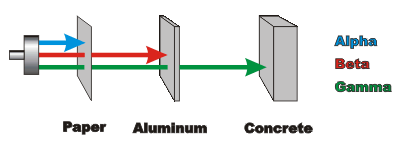.
The larger the dose of radiation the greater the risk of cancer. As radiation passes through a material it can be absorbed. The greater the thickness of a material the greater the absorption:

When sources of radiation are inside the body:
- alpha radiation is the most dangerous because it is so strongly absorbed by cells;
- beta and gamma radiation are less dangerous because cells are less likely to absorb the radiation.
When sources of radiation are outside the body:
- beta and gamma radiation are the most dangerous because they can reach the cells of organs and may be absorbed by them;
- alpha radiation is least dangerous because it is unlikely to reach living cells.
Workers who are at risk from radiation often wear a radiation badge to monitor the amount of radiation they have been exposed to over a period of time. The badge is a small packet containing photographic film. The more radiation a worker has been exposed to, the darker the film is when it has been developed.

While radiaiton is dangerous, it can be very useful, it is used to: kill harmful bacteria in food; sterilise surgical instruments; kill cancer cells.
Have a go at treating a tumour
- Why do the safety badges have 3 different windows?
- What type of radiation have these piece of photographic paper from safety badges been exposed to?